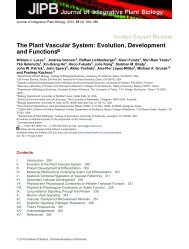Roles of SNARE Proteins in Synaptic Vesicle Fusion - Department of ...
Roles of SNARE Proteins in Synaptic Vesicle Fusion - Department of ...
Roles of SNARE Proteins in Synaptic Vesicle Fusion - Department of ...
You also want an ePaper? Increase the reach of your titles
YUMPU automatically turns print PDFs into web optimized ePapers that Google loves.
44 M.T. Palfreyman, E.M. Jorgensen<br />
<strong>SNARE</strong> motif (86). Importantly, once the neuromuscular junction was electrically<br />
stimulated, botul<strong>in</strong>um tox<strong>in</strong> B was able to block exocytosis, demonstrat<strong>in</strong>g that the<br />
crayfish synaptobrev<strong>in</strong> monomers were <strong>in</strong>deed targets for the tox<strong>in</strong>. Thus, these<br />
data suggested that the N-term<strong>in</strong>us, but not the C-term<strong>in</strong>us, <strong>of</strong> synaptobrev<strong>in</strong>, is<br />
zippered <strong>in</strong>to a <strong>SNARE</strong> complex <strong>in</strong> primed vesicles; presumably, calcium <strong>in</strong>flux<br />
stimulates full zipper<strong>in</strong>g and membrane fusion.<br />
As a second example, the mutations <strong>in</strong> the hydrophobic core <strong>of</strong> the <strong>SNARE</strong><br />
complex have been expressed <strong>in</strong> neurosecretory chromaff<strong>in</strong> cells (87,90). Mutations<br />
<strong>in</strong> the C-term<strong>in</strong>al hydrophobic core <strong>in</strong>crementally reduced the k<strong>in</strong>etics <strong>of</strong> the rapid<br />
component <strong>of</strong> secretion, while those <strong>in</strong> the N-term<strong>in</strong>al reduced the susta<strong>in</strong>ed component<br />
<strong>of</strong> release, which is thought to correspond to engagement <strong>of</strong> new <strong>SNARE</strong><br />
complexes (87). Importantly, the N-term<strong>in</strong>al mutants did not change the k<strong>in</strong>etics <strong>of</strong><br />
the fast or slow components <strong>of</strong> release, only the amplitude <strong>of</strong> the response. Thus, it<br />
was <strong>in</strong>terpreted that the C-term<strong>in</strong>al mutations were slow<strong>in</strong>g “zipper<strong>in</strong>g” while those<br />
<strong>in</strong> the N-term<strong>in</strong>al were disrupt<strong>in</strong>g nucleation <strong>of</strong> the <strong>SNARE</strong> complexes (87). By<br />
contrast, when <strong>SNARE</strong>s bear<strong>in</strong>g mutations <strong>in</strong> the hydrophobic core were <strong>in</strong>troduced<br />
<strong>in</strong>to the neurosecretory PC12 cells, there was no gradient <strong>in</strong> the efficacy <strong>of</strong><br />
mutations <strong>in</strong> the k<strong>in</strong>etics <strong>of</strong> exocytosis (90).<br />
The zipper<strong>in</strong>g <strong>of</strong> the membrane proximal portion <strong>of</strong> the <strong>SNARE</strong> complex<br />
likely serves two functions. First, the <strong>SNARE</strong>s are thought to catalyze the formation<br />
<strong>of</strong> a “hemifusion” transition state <strong>in</strong> which the proximal membrane leaflets have<br />
merged. This state can be achieved with comparatively low-energy requirements<br />
(91–94) and might simply need the <strong>SNARE</strong>s to br<strong>in</strong>g the membranes <strong>in</strong>to close<br />
proximity (95). Second, the <strong>SNARE</strong>s have been proposed to open up a fusion<br />
pore. This step requires the transmembrane doma<strong>in</strong>s <strong>of</strong> the <strong>SNARE</strong>s and likely<br />
<strong>in</strong>volves the transfer <strong>of</strong> energy from the zipper<strong>in</strong>g <strong>of</strong> the <strong>SNARE</strong> cytoplasmic<br />
doma<strong>in</strong>s be<strong>in</strong>g passed to the transmembrane doma<strong>in</strong> <strong>in</strong> order to locally disrupt<br />
lipid membranes (96).<br />
Inspired by experiments <strong>in</strong> viral fusion and model<strong>in</strong>g <strong>of</strong> lipid bilayers, it is proposed<br />
that the <strong>in</strong>itial steps <strong>of</strong> membrane merger result <strong>in</strong> a lipid stalk (97,98). The<br />
stalk corresponds to an hourglass-like structure that may conta<strong>in</strong> as few as a dozen<br />
lipid molecules (98–100). The expansion <strong>of</strong> the stalk then results <strong>in</strong> a hemifusion<br />
diaphragm (91,101). These steps are not as highly energetically unfavorable as later<br />
steps and can be experimentally observed by dehydration <strong>of</strong> planar lipid bilayers,<br />
even <strong>in</strong> the absence <strong>of</strong> <strong>SNARE</strong>s (92,93,100,102). Direct evidence for lipid stalks<br />
has come from x-ray–scatter<strong>in</strong>g experiments that have given us a structure <strong>of</strong> this<br />
<strong>in</strong>termediate (100). The hemifusion state has been shown to be a metastable <strong>in</strong>termediate<br />
<strong>in</strong> vivo and can be observed for extensive periods <strong>of</strong> time <strong>in</strong> certa<strong>in</strong> fusion<br />
reactions (103). Importantly, <strong>in</strong> vitro liposome fusion experiments have shown that<br />
hemifusion is an <strong>in</strong>termediate <strong>in</strong> the fusion pathway mediated by the synaptic vesicle<br />
<strong>SNARE</strong>s (104–106). Hemifusion <strong>in</strong>termediates have also been seen at central<br />
synapses us<strong>in</strong>g conical electron tomography; hemifused vesicles corresponded to<br />
those vesicles that were docked at the active zone (107).<br />
Aside from the tomography and x-ray–scatter<strong>in</strong>g experiments, the evidence<br />
for stalk <strong>in</strong>termediates and hemifusion diaphragms comes from two observations:<br />
Wang_Ch03.<strong>in</strong>dd 44 5/15/2008 5:27:14 PM
















